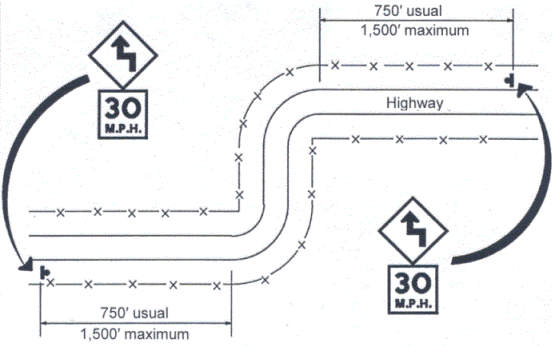Chapter 2: Regulatory and Advisory Speeds
Anchor: #i1000537Section 1: Application of Regulatory and Advisory Speeds
Anchor: #i1000542Introduction
When an engineering and traffic investigation shows that the statutory speed limits are no longer applicable for the existing conditions, the prima facie maximum speed limits should be altered accordingly with a speed zone.
The types of speed zones are as follows:
- regulatory
- construction
- school
- private road.
Each type of zone and its use is discussed later in this chapter.
Advisory speeds may be posted within speed zones to advise drivers of a safe operating speed to negotiate roadway features. This section discusses regulatory speeds and advisory speeds and explains their differences.
Anchor: #i1000589Regulatory Speeds
Regulatory speed zones should be applied only to those locations and sections of highways which are not dealt with adequately by the general statewide speed limits, and they should be indicators of the speed limitations imposed by physical and traffic conditions at such locations. Speed limits are determined by specific roadway and traffic conditions. Speed limits should not be lowered to the extent necessary for a driver to avoid a collision with a pedestrian or other motorist who is entering or crossing the highway in violation of an existing traffic regulation.
Roadway safety is an important consideration in establishing speed limits. The following factors affect roadway safety and, therefore, should be considered when establishing speed limits:
- horizontal and vertical curves
- hidden driveways and other roadside developments
- high driveway density
- crash history along the location
- rural residential or developed areas
- lack of striped, improved shoulders.
Advisory Speeds
Advisory speeds are the desirable speeds for curves, intersections, or other locations where design standards or physical conditions of the roadway restrict safe operating speeds to values less than the maximum legal speeds or posted regulatory speed limit. Figure 2-1 illustrates the use and application of warning signs with advisory speeds. For additional information on determining advisory speeds, see Chapter 5, Application of Advisory Speeds.
Figure 2-1. Typical applications of warning signs with advisory speeds. Note that distances shown are from the point of curvature.
Anchor: #i1000658Advisory Speed Sections in Regulatory Zones
If an advisory speed is located within a regulatory speed zone, it is not necessary to lower the zone speed to conform with the advisory speed. In erecting the signs, however, care should be taken not to erect a regulatory speed limit sign so near the advisory speed sign that drivers may become confused by two different speed values.
An advisory speed within a regulatory speed zone should not be posted for a value higher than the posted speed of the regulatory speed zone. Care should also be taken not to place a regulatory speed sign between an advisory speed sign and the location to which the advisory speed applies.
Anchor: #i1000673Regulatory Versus Advisory Speeds
Advisory speeds are determined primarily by physical and design characteristics of the roadway. The setting of regulatory speeds, while also affected by physical and design factors, is determined in large part by existing free flow traffic speeds.
A Transportation Commission minute order, city ordinance, or county ordinance is not required for advisory speed zones but is required for regulatory speed zones. Therefore, advisory speed zones are more flexible in that they can be changed without revising existing Commission minute orders or city or county ordinances.
From the standpoint of enforcement, when a regulatory speed zone has been established and signs are posted, the speed values shown on the signs are the maximum lawful prima facie speeds. An advisory speed sign serves to advise drivers of safe speeds that are recommended for certain roadway conditions, such as horizontal curves. It does aid the enforcement officer, however, in determining reasonable and prudent speeds. A driver might be cited for exceeding the posted value of an advisory speed zone on the grounds that they were driving at a speed that was not reasonable and prudent for the conditions existing at the time and location.
